Robert Knox's Blog, page 18
September 29, 2018
Happy Gardens! My First Poetry Collection Nominated for State Book Award
 I'm happy to share the news that my first poetry book, a chapbook titled "Gardeners Do It With Their Hands Dirty," has been nominated for The Massachusetts Book Awards. The awards are made annually to books by a Massachusetts resident or about the state that were published in the previous year.
I'm happy to share the news that my first poetry book, a chapbook titled "Gardeners Do It With Their Hands Dirty," has been nominated for The Massachusetts Book Awards. The awards are made annually to books by a Massachusetts resident or about the state that were published in the previous year. “The Massachusetts Book Awards," the program states on its website, "highlight the work of our vital contemporary writing community and encourage readers to do some 'close reading' of those imaginative works created by the authors among us." The awards recognize worthy works in fiction, nonfiction, poetry, and children's or young adult literature published in the previous year. "Gardeners Do It With Their Hands Dirty" was nominated by publisher Leah Maines of Finishing Line Press.
Published in May of 2017, it's a chapbook -- a publisher's term for a half-sized collection of poetry by a single author. A full volume of poetry runs from 64 to about 100 pages, the chapbook generally tops off in the thirties. "Gardeners" is 36 pages. It includes poems published in Verse-Virtual, where I continue to publish regularly as a contributing editor, and in six other journals, including "Off the Coast," "Guide to Kulchur Creative Journal," and "Yellow Chair Review." Here's the introduction to the collection that I wrote for the publisher: "Many of the poems in this book, especially those that relate to its title, spring from a decision following our move to a house in Quincy, Mass. -- with little lawn and no landscaping to speak of -- to dig up the turf and plant flowering perennials, ground cover, shrubs, a small tree or two, berry bushes, potted annuals, and vegetables. My first title for these poems about the garden project was "The Amateur." From a Latin root, the word means "lover." I have no training, no claim to expertise; I'm not a professional -- I don't even belong to a garden club. I simply began digging things up and planting. So, to be an amateur means to do something not for money, but for love, or desire. Years later, with mature perennials and shrubs elbowing each other for growing room, I love the idea that when we step outdoors we are in nature. The "environment" begins at the doorstep. Open the door; breathe the air; listen. One day a cardinal sat on the head of a sunflower, bobbing and calling, looking for all the world as if he had just lost something. (His mate?) I noticed he extracted a few sunflower seeds while he was there. There is always something to see. "Gardeners Do It With Their Hands Dirty" includes poems about plants, flowers, the craft of cultivation, talking to trees, getting stared at by hummingbirds. Seasons change and so do we. The second half of the collection encompasses poems about family, places near and far, my father's near-fatal journey in World War II ("My Dad's Ship But One of Three"), "The Sacred Way" at Delphi in Greece, Syrian refugees in Beirut ("Sidewalk Madonnas"), and a quick dip into formal verse with "The Slow Tritina." The Massachusetts Book Awards program was created by the Massachusetts Center for the Book, which in turn is an affiliate of Mass Humanities, the state agency that funds initiatives to promote the arts and humanities in the Commonwealth of Massachusetts.
So far my response is to follow the advice of the publisher, who says I "don't have to do anything but be happy."
I'll close with a short poem from the "Garden Lovers" sequence.
Human Bee-ing
Flowers are the sex organs Of hot momma nature. We all love the colors, the shapes, The delicate constructions. They bring us together.
Do not ask what makes that deep, persistent buzz that hovers above Zouve jackets and bell-flared trousers, transparent angel wings extended and wiggles its butt between stamen and pistil It's us
https://www.finishinglinepress.com/product/gardeners-do-it-with-their-hands-dirty-by-robert-knox/
Published on September 29, 2018 20:50
September 23, 2018
September Flowers: Some Plants Save Their Best for Summer's Last Gasp
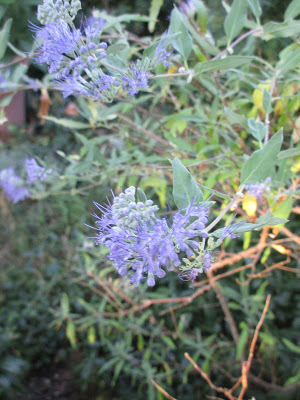 Some garden plants save their best for last. The Blossoms at left grows on a very humble, stalky looking shrub that barely survives the competition and my attempt to prolong its useful life by moving it away from some of the more robust neighbors such as the Lilac, Wiegelia and Andromeda. Still, when those spring bloomers have settled down to a green but flowerless end of summer, this humble fellow puts out his delicate blue blossoms. I believe it is called the "Buccaneer" azalea. Maybe the other azaleas turn up their early blooming noses at its slow development.
Some garden plants save their best for last. The Blossoms at left grows on a very humble, stalky looking shrub that barely survives the competition and my attempt to prolong its useful life by moving it away from some of the more robust neighbors such as the Lilac, Wiegelia and Andromeda. Still, when those spring bloomers have settled down to a green but flowerless end of summer, this humble fellow puts out his delicate blue blossoms. I believe it is called the "Buccaneer" azalea. Maybe the other azaleas turn up their early blooming noses at its slow development.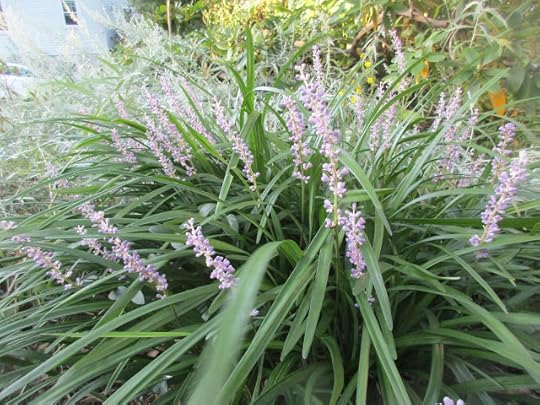
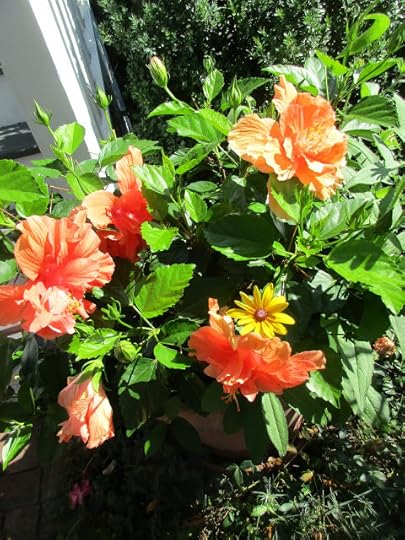 The plant in the second photo down is a flowering grass called Liriope. Again, it waits for its neighbors to do their thing, before sending out its blossoms well into August. They're still blooming now.
The plant in the second photo down is a flowering grass called Liriope. Again, it waits for its neighbors to do their thing, before sending out its blossoms well into August. They're still blooming now. 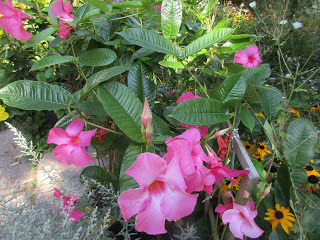 Annuals, especially plants whose true home lies considerably to the south, can be very rewarding in
Annuals, especially plants whose true home lies considerably to the south, can be very rewarding in September. We have pots of various sorts of Hibiscus, the 'annual' variety in this latitude. Plans with blooms very similar to these, if not exactly the same grow all year in subtropical climates such as Florida. The orange blossoms at the left dress up the house front.
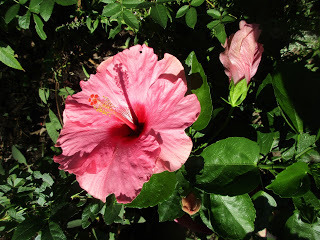 The plant below with rose-colored petals is the Mandevilia, or Mandeville Rose variety of the Hibiscus. This one is absurdly vigorous, sending is vines everywhere and producing new blossoms every few days all summer. It greets me with the lively outreach of color whenever I step outdoors to look at the backyard garden area. It's more productive this month than ever.
The plant below with rose-colored petals is the Mandevilia, or Mandeville Rose variety of the Hibiscus. This one is absurdly vigorous, sending is vines everywhere and producing new blossoms every few days all summer. It greets me with the lively outreach of color whenever I step outdoors to look at the backyard garden area. It's more productive this month than ever.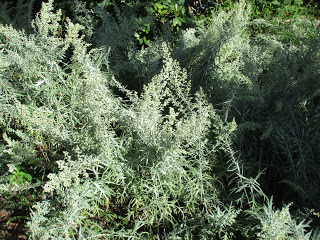 The next photo down depicts one of the smaller Hibiscus plants, this one blossoms a standard wide blossom in bright red.
The next photo down depicts one of the smaller Hibiscus plants, this one blossoms a standard wide blossom in bright red. 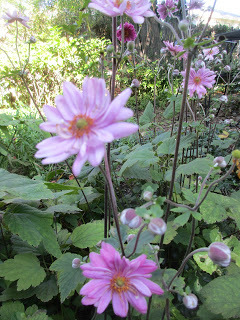 Back to the perennials. The Artemisia, which grows thick silver-gray foliage, and spreads everywhere, reaches its peak this month, when it flowers tiny, whitish buds at the ends of all its its branches and twigs. I call 'bud' because they are rounded and closed in appearance, but they never open, creating a two-toned effect on the silvery foliage.
Back to the perennials. The Artemisia, which grows thick silver-gray foliage, and spreads everywhere, reaches its peak this month, when it flowers tiny, whitish buds at the ends of all its its branches and twigs. I call 'bud' because they are rounded and closed in appearance, but they never open, creating a two-toned effect on the silvery foliage. 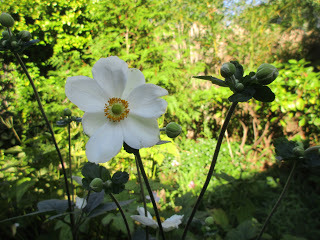 Lots of anemones of the late-blooming species bloom this month. The dark pink flowering variety are blooming now. They follow a lighter pink flower that mostly had its run last month. A third variety, producing white, chalice-like flowers, pictured below the dark pink ones, are just beginning to open now.
Lots of anemones of the late-blooming species bloom this month. The dark pink flowering variety are blooming now. They follow a lighter pink flower that mostly had its run last month. A third variety, producing white, chalice-like flowers, pictured below the dark pink ones, are just beginning to open now. I wait for these perennials every year, and they never let me down. Some of these plants are sold under the commercial name of "wind flower."
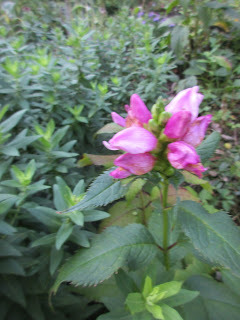 Below the photo of the white anemone, another pink to light violet flower also opens this month. This is the Turtle-head (species name Chelone glabra).
Below the photo of the white anemone, another pink to light violet flower also opens this month. This is the Turtle-head (species name Chelone glabra). The last of the perennial flowering plants pictured here are Asters, another reliable September bloomer.
The varieties pictured here are a hardy violet plant, growing up amid a thick patch of Siberian Iris, that peaked in early June. We have some more of these that have not blossomed yet.
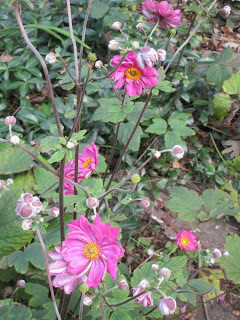 Add caption The last photo on this page shows the tall red Aster, quickly growing so tall and leggy that I will have to stake it soon. Bees love these late-blooming flowers. One of them followed us into the house this evening after we went out to visit the plant, and promptly lost himself.
Add caption The last photo on this page shows the tall red Aster, quickly growing so tall and leggy that I will have to stake it soon. Bees love these late-blooming flowers. One of them followed us into the house this evening after we went out to visit the plant, and promptly lost himself.What are the odds that I discover him someplace really inconvenient?
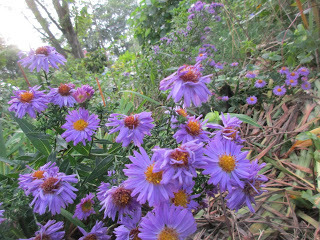
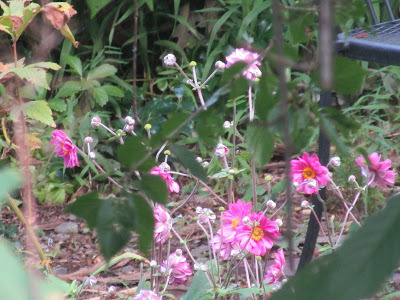
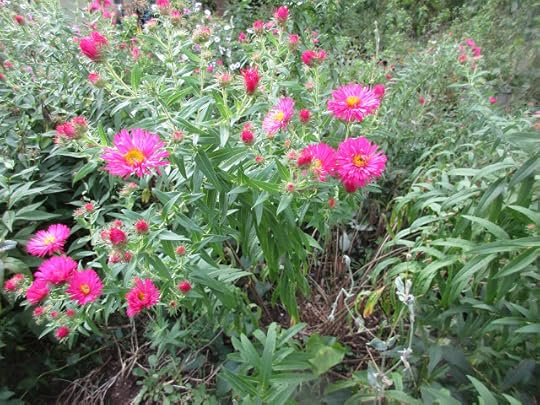
Published on September 23, 2018 17:38
The Garden of Verse: A Ragged Harp Player, A Poetess with Butterfly Wings, a Vision Doing Dishes, and Other Portraits in Verse
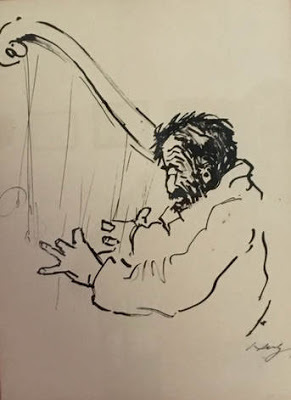
A classic form of visual art, the portrait helps us to see -- and to appreciate. Portraits in words can do the same.
Among the fine offerings in the September issue of Verse-Virtual, an elegant "ekphrastic" poem -- the term used for poems that respond to pictures -- by Steve Klepetar illuminates the truth of the image. His poem "The Harp Player" matches the style of its minimalist subject -- the image of a haggard, but devoted figure pursuing an ethereal art -- with the well chosen words of his 14 short lines.
"Someone has pulled him
from oblivion with a few
hard lines, rendered
his black, choppy hair
and bristly beard, eyes
pressed shut, open
mouth..."
And someone has rescued a remarkable work of art
with a few well-wrought lines of verse.
The portrait of a legendary poet emerges from John Stanizzi's "Looking Out Emily's Window," a poem written in a shapely appropriation of Emily Dickinson's hymn-stanza style. Following Dickinson's own poem comparing a butterfly's emergence from a cocoon to a "Lady from her Door," Stanizzi's poem suggests the spiritual arrival of the poet "dressed in cabbage White -- Lilting wings of tulle."
The Cabbage White is perhaps the most common of butterflies. After reading this poem I'll look at them more carefully in the future and try to catch a glimpse of tulle.
And yet another sort of portraiture, the capture of a precious moment, shines in Joe Cottonwood's charming "That Summer," a poem that depicts the beginning of something special at summer camp. The language is all of a piece here, from "the triple sink," the washing of 93 soup bowls ("she counts, you learn"), to the poem's reference to "Pop's wheezer Chevy truck,"' and the youthful dishwasher's hair as "a swirl on top," as the little drama proceeds to the denouement:
"She reaches in rubber gloves for a can
of Comet cleanser on a shelf over the sink
(stretching, exposing belly, unaware)
when she sees you and tries to push
the straggle of hair from her face
leaving little bubbles among the freckles."
Take the photograph right there. It's in the can.
Penny Harter's poem gives us, as the title promises, "two spiders." I don't like spiders, but I like the poem's perfect depiction of them as "black condensations/
at the seam of wall and ceiling," The poem shows us the possible scenarios for such creatures -- mating, fighting, becoming victims of human disgust -- yet spares them as bit-part players in a bigger picture:
"satellites
circling the center, living
to catch what they can
and devour it
one night at a time,
one day."
In Alan Walowitz's "Video Postcard from Vietnam," a poem deconstructing a vacation scene, we're given references to "in country," the rainy season, Hue, water buffalo, and "an ancient French garden" -- phrases and terms we might remember reading back when that country was synonymous with a long, pointless, hideous war inflicted by a 'great' country on a small one.
But just as a 'video postcard' freezes a moment in time, the poem interprets this moment to make a larger statement, offering memorable words and wider meaning to a lovely and remarkable image:
"The odd, unspoken message says,
Here is a place we feel safe.
Their fingers barely touch across
the distance between them, the width of the deck,
as they try their best to make a heart of their hands."
You can see the photo and read the words to this and the many other fine poems in the September 2018 issue of Verse-Virtual at
http://www.verse-virtual.com/poems-and-articles.html
Published on September 23, 2018 13:05
September 19, 2018
The Garden of the Tale: "The Country/The Country," My Serial Novel Mingling Politics and Fantasy Posted Online

The Country/The Country A serialized novel by Robert Knox
"One of the things science fiction does... is to extrapolate imaginatively from current trends and events to a near-future that’s half prediction, half satire.” -- Ursula Le Guin
I just posted chapters 16 to 18 of my new novel, "The Country/The Country," online on a site designed for authors of a new work. Starting last month I have posted weekly segments of the book online, following the formula of the serial novel exploited by 19th century authors such as Charles Dickens and Dostoyevsky. Inspired by the catastrophically divisive presidential election of 2016, the novel's events take place in a fictional country that shares many similarities with our own. I consider the book a combination of political satire and speculative fiction. Similarities between the fictional country of The Commonhope of UZ and the US will be apparent. But I've also given myself permission to invent characters (and a few creatures), such as a psychically empowered seer who calls herself a witch, a backwards neighboring culture from 'the North,' ancient earthly forces known as "the bodies," a near-human robotic assistant, and various spiritual aides referred to as the Ancient Ones. The principal character, named Keel, is a former college teacher pressed into early retirement by the declining interest in his academic specialty, "the classics." The chief antagonist is a wealthy politician, the principal of an international cartel called Animal Firm, whose political theories involve more frankly brutal tactics than even those currently on display in our national politics. Dogs also play a role, as does an oppressed class of gender nonconformists know as the 'flexibles,' women who can walk up walls, and the political theories readers may recognize as those attributed to the influential theorist Machiavelli. So far I have posted about one quarter of the total book. I intend to continue posting weekly segments of the ongoing story online (Wednesdays are the weekly target) through the November election. I'll post link to the site here:
https://www.inkitt.com/stories/thriller/226757/chapters/18
Click on the word "chapters" to navigate easily through the portions of the book posted so far. If you create an account on the Inkitt site (it's free), it will allow you to post comments, or a 'review,' at the end of any chapter. Posting comments, even a word or two, helps me by (among other reasons) drawing attention to the book. You don't need an account to read the work, but you do to comment. I would of course appreciate hearing what you think, as well as any amount of time and attention you can give to reading my serial novel. I'll finish this 'pitch' by posting the brief summary publishers call the 'blurb' I created for this book. And then share a few of the readers' comments I have so far been fortunate to receive on the early chapters.
BLURB
A retired teacher, Keel is an Everyman in "The Commonhope of Uz," content to be a good citizen in a country founded on the rule of law and the guidance of reason. But after a long period of prosperity under a widely admired chief executive, fears of economic stagnation and social change are driving the candidacy of a new kind of leader. Called "Pig" by his supporters, who pack rallies to show their eagerness for vague, sweeping concentrations of power, businessman Karol Pegasso dominates the country's complicated election system. Chance, or something larger, drives Keel to join an opposition, formed by young radicals and old-fashioned idealists, and led by an aging psychic who calls herself a witch. Together they summon forces beyond the old understandings of reason and law to build a wall of flesh and stop Pig's march to power. But in the end the country's safety relies on waking the slumbering giants of compassion and care, known as the Ancient Ones, "the bodies," and the Angels of Light.
My thanks to those of who commented on the early chapters. Some sample comments:
"I like sense of humor, irony, and suspense."
"Easily recognizable and relatable. I hope the citizens of UZ are able to resist! I look forward to reading more."
"Knox's fictional world is far too real. Many analogies can be made between this world and the United States in 2018. Looking forward to reading future chapters."
"Enjoying this story. Anxious for more. Knox's attention to detail is always exciting."
"Looking forward to reading the next chapter."
"Now we've been introduced to Mrs. Nathan and I'm anxious to learn more about her. A wonderful story is unfolding, which has parallels to our current society. Can't wait to see what will happen next."
Published on September 19, 2018 14:11
September 16, 2018
The Garden of Climate: Let's Give Nature Back to the Indians
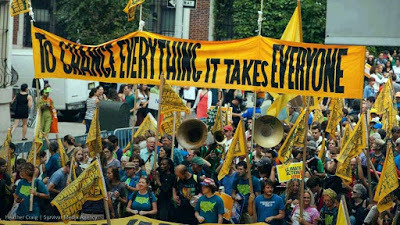 Given that the United States government has fully entered "The Age of Intentional Misrule" by ignoring science and the greatest threat to the future of humanity our species has ever faced, it is no wonder that sensible people seeking leadership, action, and hope have been forced to look elsewhere.
Given that the United States government has fully entered "The Age of Intentional Misrule" by ignoring science and the greatest threat to the future of humanity our species has ever faced, it is no wonder that sensible people seeking leadership, action, and hope have been forced to look elsewhere. Last week many political and economic leaders -- those who do not embrace the current governing party's "National Way of Selfishness and Stupidity" -- met in California for a Global Climate Action Summit to talk about what can be done, and what should be done, without relying on any support from the so-called most powerful nation on earth, the country (that's ours) that's fast proving to be the paper tiger our enemies used to call us. The State of California, the largest public entity in the United States still under rational leadership, made news when its governor announced his state's pledge to eliminate carbon emissions within 27 years. That's a good step. But the bigger, and closer, signpost is the year 2030, by which time worldwide emissions must be reduced substantially in order for the world to have a chance of keeping global warming increases within 2 percent F. Anything above that increase, according to the best projections, and we're swamped. To reach this goal, according to news reports on the climate action summit, the human world has to cut its expected annual greenhouse gas emissions by the equivalent of nearly 15 billion tons of carbon dioxide by 2030, on top of the pledges nations made at the 2015 Paris climate agreement. The pledges so far made by businesses and US state governments amount to about 4 percent of that total. So, basically, the world has a long way to go. Another perspective on what have to do -- and have to refrain from doing -- was offered by actor Harrison Ford, one of the non-scientist, non-politician celebrities to attend the Global Climate Action Summit. "I beg you," Ford told summit attendees. "Don’t forget Nature. Because, today, the destruction of nature accounts for more global emissions than all the cars and trucks in the world. We can put solar panels on every house, we can turn every car into an electric vehicle but as long as Sumatra burns—we will have failed. So long as the Amazon’s great forests are slashed and burned, so long as the protected lands of tribal people, Indigenous people, are allowed to be encroached upon, so long as wetlands and bog peats are destroyed, our climate goals will remain out of reach, and we will be shit out of time." Many of us at one time or another have donated money to organizations pledged to plant trees to fight global warning. There are many good environmental gains to be made by planting trees -- to resist environmental degradation, keep soil in lumbered areas from blowing away, enrich soil, and reduce greenhouse gases in the atmosphere because trees absorb CO2 in process of photosynthesis. But we will never be able to plant enough trees to match the global warming deficit caused by destroying earth's oldest ecological systems. Old forests in the tropical, subtropical and temperate regions are the most densely 'green' places the planet will ever see. The concentration of biota in these regions far outweighs anything man-made. All that green takes greenhouse gases out of the atmosphere. Green plants terra-formed our planet millions of years ago to make it livable for animals like ourselves by sucking carbon out of the atmosphere and sequestering it at the bottom of the ocean. And ever since their appearance here, the green life in earth's forests cleans our atmosphere.
The world's governments and businesses should by all means be working hard and fast to replace fossil fuels and the greenhouse gases they produce with renewable, non-polluting energy sources.
But we need -- as human societies -- to develop a shared data bank of wisdom that recognizes that our survival is based on developing ways to preserve the earth as a living system independent of, and more powerful than, our species. To do this we need the assistance of first peoples who have lived with the earth before, and for longer periods, than modern Western society has done. Some examples of that 'first people's perspective are provided by speakers attending the San Francisco "Rise For Climate" march for a fossil-free world. Mirian Cisneros, president of the Kichwa people of Sarayaku in Ecuadorean Amazon, called for a "Permanent protection of all forests and life in our ancestral lands" of the Kichwa people:
"I want to tell all of you that I come from those forests, rivers, lakes and mountains that have life. I come from there, where the human being and Mother Earth live in harmony. I come from Kawsak Sacha. I come from the Living Forest. I also come from a people who has fought for years and years the threats of oil exploitation. I come from the land where we have defended millions of lives. And today we are here to leave you with our Kawsak Sacha proposal, Living Forest...
"We are also here because we want the world to know that indigenous communities like ours, Sarayaku, possess innovative solutions, such as our own proposal of Kawsak Sacha, a permanent protection of all forests and life in our ancestral lands. The world requires just and noble solutions, such as this one, to confront climate change. And also we ask for respect for our indigenous rights, self-determination and our autonomy. In this way, we can guarantee the life of humanity and to live in peace."
At the same event Chief Ninawa Huni Kui stated:
"I’m from the Huni Kui people, and I am from the Brazilian Amazon in the state of Acre. I’m here to unite with other indigenous peoples and the peoples of the world, because we’re here to defend rights. The governments are going to hold a summit to decide the future of the world and the future of our peoples. Their vision of the future is just about profits, making money. And they make money by polluting and destroying this world. So I’m here to bring the voice of the Amazon rainforest to this discussion."
Our 'advanced,' Western and Westernized societies that continue to use up too much of the world's resources must turn to older societies for advice and direction; and to respect the wisdom of ways of life that we too hurriedly superseded and replaced.
Let's put these people in charge of saving nature. For only by saving their homes will we be able to save humanity.

Rise for Climate: Tens of Thousands March in San Francisco Calling for Fossil-Free World
Published on September 16, 2018 20:11
September 6, 2018
The Garden of the Seasons: More Than a Full Swallow from Jug End Trail, in Egremont, Massachusetts
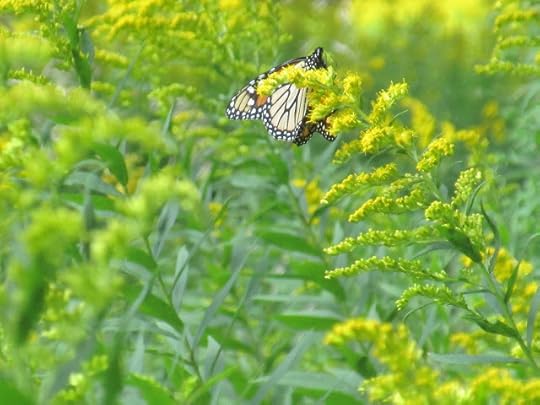
I like Mount Washington State Forest, a big hunk of Berkshire woodlands, its pretty mountain roads, and huge slabs of greenery. And I like heading off in that direction, knowing we're reaching higher elevations and 4,000 acres of undeveloped land. To get there we head south down Route 7 and then west, toward New York State. A year ago, starting from the New York side, a group of us (siblings and spouses) drove to the state preserve to find the trail to Bash Bish Falls, just across the state line into Massachusetts.
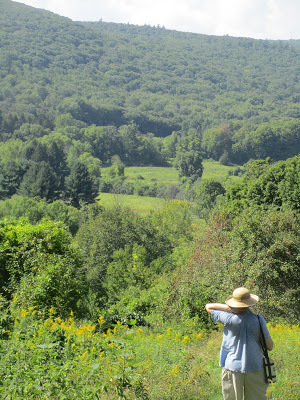
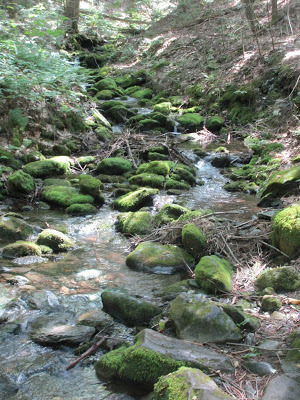 This time, on Labor Day, a day that turned unseasonably warm, we followed directions from a Berkshire County hiking guide through Great Barrington to Egremont, then down a smaller road to the state forest, turning off at one of those old mud-brown state park signs that told us we were entering a 'management area.' Just a quarter minute later we see a sign for Jug End -- it keeps a low public profile -- described as a 'State Reservation.' A free, no-hassle, modest parking area greets arrivals. The place looks well taken care of. Our hiking guide praises Jug End's trails for offering "some of the best views in the Berkshires." And, the bonus for us, you don't have to climb up a steep trail to reach them. The trail we take is a very satisfying loop marked with blue blazes. We find open fields or meadows, left wild and yet somehow managed to keep the trees from making inroads. Maybe they cut it every year in the spring. It's in full bloom now.
This time, on Labor Day, a day that turned unseasonably warm, we followed directions from a Berkshire County hiking guide through Great Barrington to Egremont, then down a smaller road to the state forest, turning off at one of those old mud-brown state park signs that told us we were entering a 'management area.' Just a quarter minute later we see a sign for Jug End -- it keeps a low public profile -- described as a 'State Reservation.' A free, no-hassle, modest parking area greets arrivals. The place looks well taken care of. Our hiking guide praises Jug End's trails for offering "some of the best views in the Berkshires." And, the bonus for us, you don't have to climb up a steep trail to reach them. The trail we take is a very satisfying loop marked with blue blazes. We find open fields or meadows, left wild and yet somehow managed to keep the trees from making inroads. Maybe they cut it every year in the spring. It's in full bloom now. Wild meadows in September are a delight. Many wild plants like Queen Anne's Lace are still blooming, spilling all over one another and mixing with asters and other late bloomers. Some, like the Goldenrod pictured above, are just reaching their peak. Butterflies are all over the meadows as well. We pass through two fields, according to the guide, but it seems like more because of the trail loop, or the choices we make while walking along soft pathways of recently mowed wild grasses. Someone, as I said, is keeping the place neat and pretty.
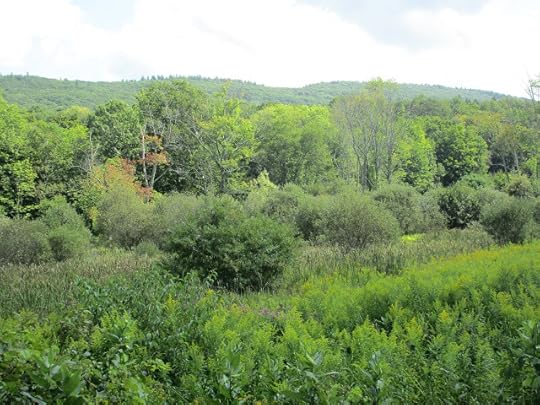 The vast greeny hillsides arise from the field's far side. We take out our cameras and photograph all the vistas. The sky is blue over the green ridge line, and above the hills at the edge of vision a few puffy cumulus clouds hang amid all that blue and drift in the most ephemeral of the four elements. The clouds are like liquid time. We perspire in the September sun that gilds the land, the air, the flesh below, warm as the early summer sun of those long-lasting solstice days.
The vast greeny hillsides arise from the field's far side. We take out our cameras and photograph all the vistas. The sky is blue over the green ridge line, and above the hills at the edge of vision a few puffy cumulus clouds hang amid all that blue and drift in the most ephemeral of the four elements. The clouds are like liquid time. We perspire in the September sun that gilds the land, the air, the flesh below, warm as the early summer sun of those long-lasting solstice days.
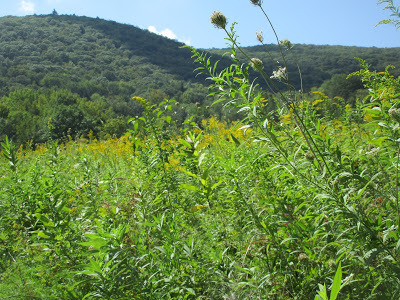 Our blue-blazed trail dips beneath the cover of trees, and we follow a woodland path alongside a brook, looping back where the brook ends, meeting a few happy visitors looping from the other direction. All wearing the smiley glaze of a happy day in the elements. Coming back along the field-margin path we are sun-struck a second time after the cooler sanctum of the woodland, and astonished anew by the even richer depths of September gold as the sun loops in its own journey toward the western skies.
Our blue-blazed trail dips beneath the cover of trees, and we follow a woodland path alongside a brook, looping back where the brook ends, meeting a few happy visitors looping from the other direction. All wearing the smiley glaze of a happy day in the elements. Coming back along the field-margin path we are sun-struck a second time after the cooler sanctum of the woodland, and astonished anew by the even richer depths of September gold as the sun loops in its own journey toward the western skies.Here's some useful information, how to get there, etc., from the state's park department:
https://www.mass.gov/locations/jug-end-state-reservation-wildlife-management-area
Published on September 06, 2018 20:50
September 3, 2018
The Garden of Verse: New Month, New Poems to School Us in the Ways of the World
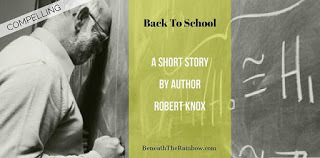 September's Verse-Virtual, the online poetry journal, offers poems by 34 poets, including "Why Do We Have to Have a Seating Chart" by Sylvia Cavanaugh.
September's Verse-Virtual, the online poetry journal, offers poems by 34 poets, including "Why Do We Have to Have a Seating Chart" by Sylvia Cavanaugh. This is not only a good poem, and a good poem about going to school, it's also a good argument for the existence of public schools.
The poem "Why Do We Have to Have a Seating Chart" begins this way:
Because structure breeds creation
because this city is segregated
because you don’t live near her
because she goes to her synagogue once a week
because you don’t speak her language
because poverty speaks its own language...
In her author's note to this poem, Sylvia writes: "High school can feel so vibrant and alive with the mix of students all interacting and learning about each other. Sometimes though, students resist this newness and want to associate and sit with only those they know already. I change my seating chart about every three weeks and my students have come to appreciate the variety of students they sit near and work with...." This poem grabbed me with its first few lines and had me ready to march in favor of more federal money for public schools before you could say "Betsy DeVos." Please read the rest of Sylvia's poem at http://www.verse-virtual.com/sylvia-cavanaugh-2018-september.html
But, whoops, here comes another perspective on school days from poet Donna Hilbert, who states in her introduction to her poem "Mr. Eliot: that it concerns "the most influential teacher I ever had, I am sorry to say." We're well warned; her poem begins:
My bald-headed sixth-grade teacher,
Mr. Eliot, put me in the cloakroom
to teach me a lesson.
He said, get used to it,
you’re not the teacher’s pet anymore.
He gave me a bucket
and said, when you fill it with tears
you can come out.
Yes, we need good schools. We need fewer 'Mr. Eliots' in them. Read the rest of Donna's poem at http://www.verse-virtual.com/donna-hilbert-2018-september.html
Mike Minassian's poem "The Fallout Shelter" takes us to school (informally speaking) on another subject. When a survivalist shelter is built in a family's backyard, it turns out to be an unconventional approach to what people need to survive:
....one room lined with shelves
filled not with the jars of food,
saltine tins, and jugs of water
we half expected, but instead
books of poetry and long-lost novels,
Picasso prints and Rembrandt self-portraits,
my parent’s wedding photo,
and tiny handprints of my sister and me at birth
leaned up against my grandmother’s
hand crocheted lace doily.
You can read the rest of Mike's poem at http://www.verse-virtual.com/michael-minassian-2018-september.html
For something completely different, my own poem "Long Island Calling" is an attempt at dialoguing with Walt Whitman's great poem about middle age, "As I Ebb'd with the Ocean of Life." In his poem Walt uses the Indian name for Long Island, "Paumanok." My poem begins this way:
Are you gently then my lover?
Calling Walt, on the shore, Paumanok 5-1-6
I too walked these shores, troubled and down-hearted,
life-wrestling, though not like you with the gods of Jacob's Ladder
who page their poet on the daemon line,
brooding-busy with lower concerns -- and now this!
As you ebb with the tide of life
late thirties poor unmarried son of a failing line,
to live once more with your special, easily agitated brother in the Brooklyn walk-up
on whose bed you sat one evening entertaining Bronson Alcott and Thoreau,
who watched you as if an animal could speak
Enough to send me haunting the endless Paumanok shoreline
(and I'm not sure I'd return)...
You can read the rest of this poem at http://www.verse-virtual.com/robert-knox-2018-september.html
For the full contents of September 2018 issue of Verse-Virtual see http://www.verse-virtual.com/poems-and-articles.html
Published on September 03, 2018 22:28
August 23, 2018
The Garden of History: From Boston to Italy, and From 1927 to 1977 to 2018: Remembering Sacco and Vanzetti

 A brilliant program by the Sacco Vanzetti Commemoration Society took place last night (Wednesday) in remembrance of the wrongful execution of the two Italian immigrants on this date in 1927. The event at the Dante Alighieri Society hall in Cambridge included moving film footage of the funeral march as tens of thousands of mourners accompanied the caskets from Hanover Street in the North End of Boston to Forest Hills Cemetery in Jamaica Plain. Former Governor Michael Dukakis, who issued a proclamation in 1977 condemning their trial's injustice and removing all guilt from the names of Nicolo Sacco and Bartolomeo Vanzetti, recounted memories of his own family's immigration experiences and of the contributions of other immigrant families to America's 20th century growth and prosperity. He also recalled picking up work for a local business from a printing shop in Boston's North End run by Aldino Felicani. Felicani was the founder, and treasurer, of the Sacco-Vanzetti Defense Committee, which raised funds to fight for the defendants through the seven years between their arrest and execution. Those kinds of connections run through local history. The degrees of separation between Boston area families and the infamous, international affair of the Sacco-Vanzetti case are fewer than we realize. It's because of Felicani's efforts that so many materials and physical artifacts from the case, and the lives of the two victims of a state conspiracy and the widespread prejudice that existed in the early decades of the 20th century against Italian immigrants.
A brilliant program by the Sacco Vanzetti Commemoration Society took place last night (Wednesday) in remembrance of the wrongful execution of the two Italian immigrants on this date in 1927. The event at the Dante Alighieri Society hall in Cambridge included moving film footage of the funeral march as tens of thousands of mourners accompanied the caskets from Hanover Street in the North End of Boston to Forest Hills Cemetery in Jamaica Plain. Former Governor Michael Dukakis, who issued a proclamation in 1977 condemning their trial's injustice and removing all guilt from the names of Nicolo Sacco and Bartolomeo Vanzetti, recounted memories of his own family's immigration experiences and of the contributions of other immigrant families to America's 20th century growth and prosperity. He also recalled picking up work for a local business from a printing shop in Boston's North End run by Aldino Felicani. Felicani was the founder, and treasurer, of the Sacco-Vanzetti Defense Committee, which raised funds to fight for the defendants through the seven years between their arrest and execution. Those kinds of connections run through local history. The degrees of separation between Boston area families and the infamous, international affair of the Sacco-Vanzetti case are fewer than we realize. It's because of Felicani's efforts that so many materials and physical artifacts from the case, and the lives of the two victims of a state conspiracy and the widespread prejudice that existed in the early decades of the 20th century against Italian immigrants. He also preserved film footage of that famous funeral march. Generally regarded as the largest public gathering in Boston in 20th century, the march's numbers were estimated by the police at 20,000 and ten times that many by the city's newspapers. Felicani's film is the only record of that day, because the federal government successfully pressured Hollywood's newsreel companies to destroy all their coverage related to Sacco and Vanzetti.
It was government censorship. And of course we're not supposed to do that in America. Why is it, Dukakis asked at the commemoration (I'm paraphrasing here), that human beings can believe such terrible things about people who are another color or have a different religion, or are simply from a different country? That question of course has a terrible relevance today. In the 19th century, Dukakis pointed out, the prejudice against outsiders was directed against the Irish. The Chinese were the banned by the exclusion act of 1882. Today, it's the Muslim travel ban. But in the early 20th century the anti-immigrant bias was directed toward the flow of immigrants from "Southern Europe," he said. "Italians, Greeks, and Portuguese."
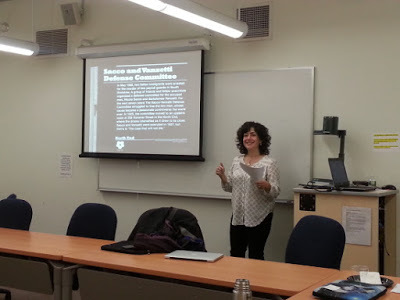 Building on the Felicani collection and other sources, Professor Michele Fazio of the University of North Carolina at Pembroke also spoke at the commemoration, sharing slides and stories of her research into the lives of the principals and the impact of their case on their Italian birthplace communities, in a talk entitled "Mining the Archives: In the lives of Sacco and Vanzetti." She traveled to each man's birthplace, Sacco's in the town of Torremaggiore in the south of Italy; Vanzetti's in Villafalletto in the northwest region of the Piemonte. She pointed out that the case and its victims are well remembered in Italy, while they are largely forgotten by the American public. In fact, family memories of both men evoke strong emotions. A traditional memorial plaque in the cemetery at Villfaletto preserves the memory of a famous native son whose death symbolized the continuing oppression of the poor and the working class. In Torremaggiore, a memorial executed in a modern looking vertical column remembers Sacco's life. Locals in both communities extended a remarkable degree of hospitality on her visit, Fazio said. "You have to eat first, and then you can talk. She also showed slides of newspaper coverage of the ongoing story in America, including frequent depictions of Rosa Sacco, the defendant's wife and mother of his children, to illustrate the personal side and family impact of the case. Later the newspapers ran photos of Vanzetti's sister, Luigia, who arrived for a last meeting with her brother just days before his execution.
Building on the Felicani collection and other sources, Professor Michele Fazio of the University of North Carolina at Pembroke also spoke at the commemoration, sharing slides and stories of her research into the lives of the principals and the impact of their case on their Italian birthplace communities, in a talk entitled "Mining the Archives: In the lives of Sacco and Vanzetti." She traveled to each man's birthplace, Sacco's in the town of Torremaggiore in the south of Italy; Vanzetti's in Villafalletto in the northwest region of the Piemonte. She pointed out that the case and its victims are well remembered in Italy, while they are largely forgotten by the American public. In fact, family memories of both men evoke strong emotions. A traditional memorial plaque in the cemetery at Villfaletto preserves the memory of a famous native son whose death symbolized the continuing oppression of the poor and the working class. In Torremaggiore, a memorial executed in a modern looking vertical column remembers Sacco's life. Locals in both communities extended a remarkable degree of hospitality on her visit, Fazio said. "You have to eat first, and then you can talk. She also showed slides of newspaper coverage of the ongoing story in America, including frequent depictions of Rosa Sacco, the defendant's wife and mother of his children, to illustrate the personal side and family impact of the case. Later the newspapers ran photos of Vanzetti's sister, Luigia, who arrived for a last meeting with her brother just days before his execution.
 Professor Fazio is writing a book on the family, class and gender issues highlighted by the Sacco-Vanzetti case. She told me her book will include a discussion of "Suosso's Lane," my novel on the Plymouth, Mass. roots of the famous case in a chapter on the literature of the Sacco and Vanzetti case. Vanzetti lived on Suosso's Lane, a quiet street in North Plymouth for four years before his arrest. My depiction of the character of the idealistic Bartolomeo Vanzetti is based on the oral history recollections of those who knew him well in those days, including the Brini family of Suosso's Lane.
Professor Fazio is writing a book on the family, class and gender issues highlighted by the Sacco-Vanzetti case. She told me her book will include a discussion of "Suosso's Lane," my novel on the Plymouth, Mass. roots of the famous case in a chapter on the literature of the Sacco and Vanzetti case. Vanzetti lived on Suosso's Lane, a quiet street in North Plymouth for four years before his arrest. My depiction of the character of the idealistic Bartolomeo Vanzetti is based on the oral history recollections of those who knew him well in those days, including the Brini family of Suosso's Lane.
Published on August 23, 2018 12:12
August 21, 2018
The Garden of the Seasons: August Lights, from Anemone to Fairy Candles, Plus a Brief Royal Visit
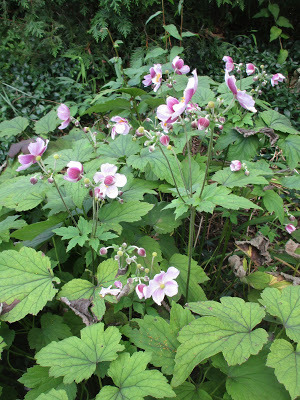
Faulkner titled one of his grim novels "Light in August."
There is something special about the light in the month of August, the last full month of summer -- and it's not at all grim -- but I have to report not seeing much of it lately. We had a record hot first week this August, accompanied by that special dog-day humidity that made the air-conditioner, so popular in this over-heated decade, work overtime.
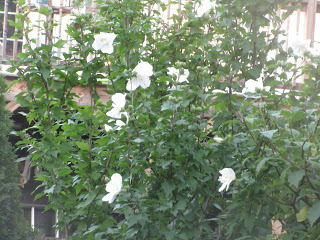
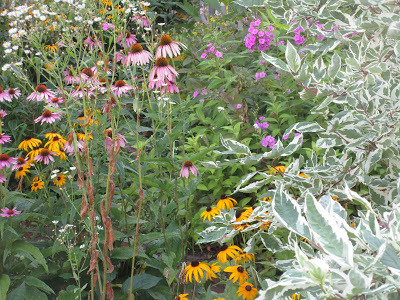 And then we got the current repeating pattern of rainy, sticky, cloud, on-and-off rain, some thunderstorms, followed by beautifully clear spells of brilliant sunshine lasting whole hours or two, then back to the clouds and scattered storm predictions. Does that sound about right?
And then we got the current repeating pattern of rainy, sticky, cloud, on-and-off rain, some thunderstorms, followed by beautifully clear spells of brilliant sunshine lasting whole hours or two, then back to the clouds and scattered storm predictions. Does that sound about right? 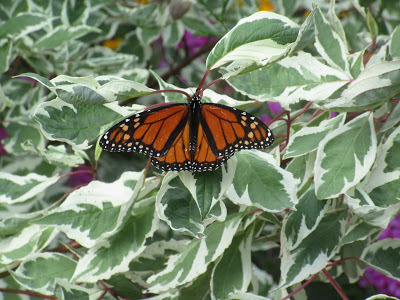 August is late summer. One of the flower garden's annual treats is the arrival of the fall-blooming anemones (top photo). Which, I am informed by the website Gardenia are also known as Japanese anemones and "windflower." Actually I recall the latter name from the garden centers where I purchased a few. These August-flowering plants are native to China, and have been cultivated by the Japanese for centuries. A special benefit is their long blooming season, six to eight weeks. The meter on our first bloomers has been running for about three weeks.
August is late summer. One of the flower garden's annual treats is the arrival of the fall-blooming anemones (top photo). Which, I am informed by the website Gardenia are also known as Japanese anemones and "windflower." Actually I recall the latter name from the garden centers where I purchased a few. These August-flowering plants are native to China, and have been cultivated by the Japanese for centuries. A special benefit is their long blooming season, six to eight weeks. The meter on our first bloomers has been running for about three weeks. We grow three different cultivars. The light pink, dark-centered one, blooming now. An all-white flowering plant. And some plants with a darker pink flower, that generally carry us into October.
The second photo down shows the Rose of Sharon, which began blooming at the end of July. This tall-growing shrub
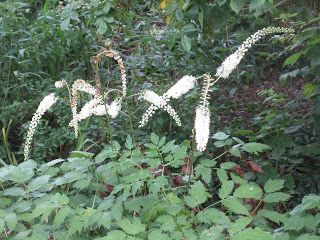 spends most of its blooms on the higher branches where the light is best. It's also been forced to grow high to escape the clutches of its very close neighbor, a Korean lilac whose steady expansion is leaning into taller plant's personal space. I like watching how the plants adapt to one another.
spends most of its blooms on the higher branches where the light is best. It's also been forced to grow high to escape the clutches of its very close neighbor, a Korean lilac whose steady expansion is leaning into taller plant's personal space. I like watching how the plants adapt to one another.The third photo down pictures a low-growing dogwood with two-toned leaves. The bloomers in this photo are the dark pink tall phlox, the Black-Eyed Susan, and the light pink cone flowers. All of these started blooming in July and continue through this month.
One of this season's most regal visitors is the Monarch butterfly, lord of all he sees, at least in my opinion. We saw him for weeks darting through the neighborhood's backyards. Our neighbor across the street has a row of marvelous butterfly bushes (Buddliea). He also darted, at great speed and in constant motion, through our gardens, front and back of the house, and I lay in wait with the camera, hoping to catch him napping. Basically, as I discovered, butterflies don't nap. I finally caught him catching a breather on the Dogwood.
The last photo depicts woodland plant called Fairy Candles. The species name is Actaea racemosa. This is a shade plant whose long white blossoms peak in late July and early August. Like the others shown here, it brings color in a season when most perennials have quieted down.
Published on August 21, 2018 20:33
August 15, 2018
'The Country' Garden: Please Take a Look at My Novel "The Country/The Country." First Chapters Posted Online
 I'm going live with my latest book, rather than waiting around for a traditional publisher to take a chance me. I'm putting it online, in weekly segments, like an old-fashioned serial novel.
I'm going live with my latest book, rather than waiting around for a traditional publisher to take a chance me. I'm putting it online, in weekly segments, like an old-fashioned serial novel. Called "The Country/The Country," the novel is a speculative fiction inspired by the catastrophically divisive Presidential election of 2016. The story takes place in a fictional country much like our own, in which a "strong man" candidate seeks to take power using fraud and intimidation. Here's the short plot summary that publishers call the "blurb."
A retired teacher, Keel is an Everyman in "The Commonhope of Uz," content to be a good citizen in a country founded on the rule of law and the guidance of reason. But after a long period of prosperity under a widely admired chief executive, fears of economic stagnation and social change are driving the candidacy of a new kind of leader. Called "Pig" by his supporters, who pack rallies to show their eagerness for vague, sweeping concentrations of power, businessman Karol Pegasso dominates the country's complicated election system. Chance, or something larger, drives Keel to join an opposition formed by young radicals and old-fashioned idealists, and led by an aging psychic who calls herself a witch. Together they summon forces beyond the old understandings of reason and law to build a wall of flesh and stop Pig's march to power. But in the end the country's safety relies on waking the slumbering giants of compassion and care, known as the Ancient Ones, "the bodies," and the Angels of Light.
I will be enormously grateful to any and all willing to take a look at the book's first five chapters. I've posted them at https://www.inkitt.com/stories/thriller/226757?utm_source=share_author_reminder
The chapters are short. Please leave a comment; even a word or two helps. I'll be posting new chapters every week. It's been fun for me to write. I hope you find it fun to read.
Published on August 15, 2018 10:13



